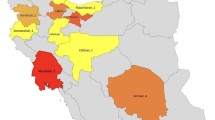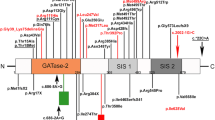Abstract
Congenital myasthenic syndrome (CMS) is a clinically and genetically heterogeneous group of inherited disorders of the neuromuscular junction. A difficult to diagnose subgroup of CMS is characterised by proximal muscle weakness and fatigue while ocular and facial involvement is only minimal. DOK7 mutations have been identified as causing the disorder in about half of the cases. More recently, using classical positional cloning, we have identified mutations in a previously unrecognised CMS gene, GFPT1, in a series of DOK7-negative cases. However, detailed description of clinical features of GFPT1 patients has not been reported yet. Here we describe the clinical picture of 24 limb-girdle CMS (LG-CMS) patients and pathological findings of 18 of them, all carrying GFPT1 mutations. Additional patients with CMS, but without tubular aggregates, and patients with non-fatigable weakness with tubular aggregates were also screened. In most patients with GFPT1 mutations, onset of the disease occurs in the first decade of life with characteristic limb-girdle weakness and fatigue. A common feature was beneficial and sustained response to acetylcholinesterase inhibitor treatment. Most of the patients who had a muscle biopsy showed tubular aggregates in myofibers. Analysis of endplate morphology in one of the patients revealed unspecific abnormalities. Our study delineates the phenotype of CMS associated with GFPT1 mutations and expands the understanding of neuromuscular junction disorders. As tubular aggregates in context of a neuromuscular transmission defect appear to be highly indicative, we suggest calling this condition congenital myasthenic syndrome with tubular aggregates (CMS-TA).



Similar content being viewed by others
Abbreviations
- AChE:
-
Acetylcholinesterase
- AChR:
-
Acetylcholine receptor
- CK:
-
Creatine kinase
- CMAP:
-
Compound muscle action potential
- CMS:
-
Congenital myasthenic syndrome
- 3,4-DAP:
-
3,4-Diaminopyridine
- DOK7 :
-
Downstream of kinase 7 gene
- EM:
-
Electron microscopy
- EMG:
-
Electromyography
- LG-CMS:
-
Limb-girdle congenital myasthenic syndrome
- NMJ:
-
Neuromuscular junction
- RNS:
-
Repetitive nerve stimulation
- SFEMG:
-
Single-fiber EMG
- TA:
-
Tubular aggregates
- GFPT1/GFAT1 :
-
Glutamine-fructose-6-phosphate transaminase 1
References
Engel AG, Sine SM (2005) Current understanding of congenital myasthenic syndromes. Curr Opin Pharmacol 5:308–321
Müller JS, Mihaylova V, Abicht A, Lochmuller H (2007) Congenital myasthenic syndromes: spotlight on genetic defects of neuromuscular transmission. Expert Rev Mol Med 9:1–20
McQuillen MP (1966) Familial limb-girdle myasthenia. Brain 89:121–132
Beeson D, Higuchi O, Palace J, Cossins J, Spearman H, Maxwell S, Newsom-Davis J, Burke G, Fawcett P, Motomura M et al (2006) Dok-7 mutations underlie a neuromuscular junction synaptopathy. Science (New York, NY) 313:1975–1978
Ben Ammar A, Petit F, Alexandri N, Gaudon K, Bauche S, Rouche A, Gras D, Fournier E, Koenig J, Stojkovic T et al (2010) Phenotype genotype analysis in 15 patients presenting a congenital myasthenic syndrome due to mutations in DOK7. J Neurol 257:754–766
Müller JS, Herczegfalvi A, Vilchez JJ, Colomer J, Bachinski LL, Mihaylova V, Santos M, Schara U, Deschauer M, Shevell M et al (2007) Phenotypical spectrum of DOK7 mutations in congenital myasthenic syndromes. Brain 130:1497–1506
Palace J, Lashley D, Newsom-Davis J, Cossins J, Maxwell S, Kennett R, Jayawant S, Yamanashi Y, Beeson D (2007) Clinical features of the DOK7 neuromuscular junction synaptopathy. Brain 130:1507–1515
Selcen D, Milone M, Shen XM, Harper CM, Stans AA, Wieben ED, Engel AG (2008) Dok-7 myasthenia: phenotypic and molecular genetic studies in 16 patients. Ann Neurol 64:71–87
Anderson JA, Ng JJ, Bowe C, McDonald C, Richman DP, Wollmann RL, Maselli RA (2008) Variable phenotypes associated with mutations in DOK7. Muscle Nerve 37:448–456
Senderek J, Müller JS, Dusl M, Strom TM, Guergueltcheva V, Diepolder I, Laval SH, Maxwell S, Cossins J, Krause S et al (2011) Hexosamine biosynthetic pathway mutations cause neuromuscular transmission defect. Am J Hum Genet 88:162–172
Haltiwanger RS, Lowe JB (2004) Role of glycosylation in development. Annu Rev Biochem 73:491–537
Rodolico C, Toscano A, Autunno M, Messina S, Nicolosi C, Aguennouz M, Laura M, Girlanda P, Messina C, Vita G (2002) Limb-girdle myasthenia: clinical, electrophysiological and morphological features in familial and autoimmune cases. Neuromuscul Disord 12:964–969
Sieb JP, Tolksdorf K, Dengler R, Jerusalem F (1996) An autosomal-recessive congenital myasthenic syndrome with tubular aggregates in a Libyan family. Neuromuscul Disord 6:115–119
Ohno K, Tsujino A, Brengman JM, Harper CM, Bajzer Z, Udd B, Beyring R, Robb S, Kirkham FJ, Engel AG (2001) Choline acetyltransferase mutations cause myasthenic syndrome associated with episodic apnea in humans. Proc Natl Acad Sci USA 98:2017–2022
Chevessier F, Bauche-Godard S, Leroy JP, Koenig J, Paturneau-Jouas M, Eymard B, Hantai D, Verdiere-Sahuque M (2005) The origin of tubular aggregates in human myopathies. J Pathol 207:313–323
Slater CR, Fawcett PR, Walls TJ, Lyons PR, Bailey SJ, Beeson D, Young C, Gardner-Medwin D (2006) Pre- and post-synaptic abnormalities associated with impaired neuromuscular transmission in a group of patients with ‘limb-girdle myasthenia’. Brain 129:2061–2076
Azulay JP, Pouget J, Figarella-Branger D, Colamarino R, Pellissier JF, Serratrice G (1994) Isolated proximal muscular weakness disclosing myasthenic syndrome. Rev Neurol (Paris) 150:377–381
Dobkin BH, Verity MA (1978) Familial neuromuscular disease with type 1 fiber hypoplasia, tubular aggregates, cardiomyopathy, and myasthenic features. Neurology 28:1135–1140
Furui E, Fukushima K, Sakashita T, Sakato S, Matsubara S, Takamori M (1997) Familial limb-girdle myasthenia with tubular aggregates. Muscle Nerve 20:599–603
Johns TR, Campa JF, Adelman LS (1973) Familial myasthenia with ‘tubular aggregates’ treated with prednisone. Neurology 73:426
Johns TR, Campa JF, Crowley WJ, Miller JQ (1971) Familial myasthenic myopathy. Neurology 71:449
Zephir H, Stojkovic T, Maurage CA, Hurtevent JF, Vermersch P (2001) Tubular aggregate congenital myopathy associated with neuromuscular block. Rev Neurol (Paris) 157:1293–1296
Schara U, Barisic N, Deschauer M, Lindberg C, Straub V, Strigl-Pill N, Wendt M, Abicht A, Muller JS, Lochmuller H (2009) Ephedrine therapy in eight patients with congenital myasthenic syndrome due to DOK7 mutations. Neuromuscul Disord 19:828–832
Lashley D, Palace J, Jayawant S, Robb S, Beeson D (2010) Ephedrine treatment in congenital myasthenic syndrome due to mutations in DOK7. Neurology 74:1517–1523
Mihaylova V, Müller JS, Vilchez JJ, Salih MA, Kabiraj MM, D’Amico A, Bertini E, Wolfle J, Schreiner F, Kurlemann G et al (2008) Clinical and molecular genetic findings in COLQ-mutant congenital myasthenic syndromes. Brain 131:747–759
Müller JS, Mildner G, Muller-Felber W, Schara U, Krampfl K, Petersen B, Petrova S, Stucka R, Mortier W, Bufler J et al (2003) Rapsyn N88 K is a frequent cause of congenital myasthenic syndromes in European patients. Neurology 60:1805–1810
Cossins J, Burke G, Maxwell S, Spearman H, Man S, Kuks J, Vincent A, Palace J, Fuhrer C, Beeson D (2006) Diverse molecular mechanisms involved in AChR deficiency due to rapsyn mutations. Brain 129:2773–2783
Oki T, Yamazaki K, Kuromitsu J, Okada M, Tanaka I (1999) cDNA cloning and mapping of a novel subtype of glutamine:fructose-6-phosphate amidotransferase (GFAT2) in human and mouse. Genomics 57:227–234
Niimi M, Ogawara T, Yamashita T, Yamamoto Y, Ueyama A, Kambe T, Okamoto T, Ban T, Tamanoi H, Ozaki K et al (2001) Identification of GFAT1-L, a novel splice variant of human glutamine: fructose-6-phosphate amidotransferase (GFAT1) that is expressed abundantly in skeletal muscle. J Hum Genet 46:566–571
Pavlovicova M, Novotova M, Zahradnik I (2003) Structure and composition of tubular aggregates of skeletal muscle fibres. Gen Physiol Biophys 22:425–440
Engel WK, Bishop DW, Cunningham GG (1970) Tubular aggregates in type II muscle fibers: ultrastructural and histochemical correlation. J Ultrastruct Res 31:507–525
Schubert W, Sotgia F, Cohen AW, Capozza F, Bonuccelli G, Bruno C, Minetti C, Bonilla E, Dimauro S, Lisanti MP (2007) Caveolin-1(−/−)- and caveolin-2(−/−)-deficient mice both display numerous skeletal muscle abnormalities, with tubular aggregate formation. Am J Pathol 170:316–333
Acknowledgments
We wish to thank the patients and their families for participating in this study. The Institute of Genetic Medicine in Newcastle is part of the MRC centre for Neuromuscular Diseases. AA, JK, BS, RH, TV and HL are members of the German Muscular Dystrophy Network (MD-NET 01GM0601) funded by the German Ministry of Education and Research (BMBF, Bonn, Germany; http://www.md-net.org). Newcastle University and MD-NET are partners of TREAT-NMD (EC, 6th FP, proposal #036825; http://www.treat-nmd.eu). VG is a research fellow of the Alexander von Humboldt Foundation. JS is a Heisenberg fellow of the Deutsche Forschungsgemeinschaft. AA is supported by a grant from the Deutsche Forschungsgemeinschaft (Ab 130/2-1), DB by grants from the Medical Research Council, the Myasthenia Gravis Association and the Muscular Dystrophy Campaign. JSM receives a research fellowship by the Faculty of Medical Sciences, Newcastle University. NM received a fellowship from the Instituto de Salud Carlos III and Fundación para la Investigación del Hospital Universitario La Fe (CM06/00154). JJV and NM are members of CIBER de Enfermedades Neurodegenerativas (CIBERNED), Valencia, Spain.
Conflict of interest
None.
Author information
Authors and Affiliations
Corresponding author
Additional information
V. Guergueltcheva and J. S. Müller contributed equally to the study.
Rights and permissions
About this article
Cite this article
Guergueltcheva, V., Müller, J.S., Dusl, M. et al. Congenital myasthenic syndrome with tubular aggregates caused by GFPT1 mutations. J Neurol 259, 838–850 (2012). https://doi.org/10.1007/s00415-011-6262-z
Received:
Revised:
Accepted:
Published:
Issue Date:
DOI: https://doi.org/10.1007/s00415-011-6262-z




